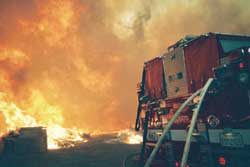
NIOSH Cedar Fire Report
CDF Cedar Fire Report
Novato FPD Investigation Analysis
Draft Standard Operating Procedures
Inaja Fire Tragedy
|

A Career Fire
Fighter was Killed and a Career Captain was Severely Injured During a
Wildland/Urban Interface Operation - California
SUMMARY
On October 29, 2003, a 38-year-old male career fire fighter (the victim)
was killed and a 48-year-old male career Captain was severely injured
when fire overran their position. The incident occurred during the protection
of a residential structure during a wildland fire operation that eventually
consumed more than 280,000 acres. The victim and his crew were part of
a task force assigned to protect a number of residential structures located
along a ridge on the flank of the fire. The victim’s crew was in
the process of preparing to defend the structure when the fire made a
slope and wind-driven run through heavy brush directly toward their position.
The crew retreated to the residential structure to seek refuge from the
oncoming fire. Two of the four crew members were able to get into the
structure while the Captain was attempting to assist the victim as the
fire reached their position. The victim died near the structure and the
Captain, who was seriously burned, had to be assisted into the structure
by the other crew members.
NIOSH investigators concluded that, to minimize the risk of similar occurrences,
fire departments and fire service agencies should:
-
ensure that the authority to conduct
firing out or burning out operations is clearly defined in the standard
operating procedure (SOP) or incident action plan (IAP) and is closely
coordinated with all supervisors, command staff and adjacent ground
forces
-
ensure that all resources, especially
those operating at or near the head of the fire, are provided with
current and anticipated weather information
-
stress the importance of utilizing
LCES (Lookouts, Communications, Escape Routes and Safety Zones) to
help identify specific trigger points (e.g., extreme fire behavior,
changes in weather, location of fire on the ground, etc) that indicate
the need for a crew to use their escape route(s), and/or seek refuge
in a designated safety zone
-
ensure that, at a minimum, high-risk
geographic areas are identified (e.g.; topography, fuels, property,
etc.) as part of the pre-planning process and provide this information
to assigned crews
-
ensure that incident command system
(ICS) span-of-control recommendations are maintained
consider the implementation of a carbon
monoxide-based monitoring program for wildland fire fighters
Additionally,
State agencies, local municipalities
and community organizations should consider developing statewide guidelines
and local community plans for managing fuels in the wildland/urban interface
Fire departments and fire service agencies
should provide members with annual medical evaluations consistent with
NFPA 1582, Standard on Comprehensive Occupational Medical Program for
Fire Departments
-
Standard setting bodies
(e.g., NFPA, NWCG, etc.) should consider developing a national standard
that fire fighters can utilize during wildfire incidents for identifying
and marking wildland/urban interface properties based on the ability
to defend the structure(s) located on that property

Incident Scene
<<<
continue reading—NIOSH Report, Introduction >>>
| The Fire Fighter Fatality
Investigation and Prevention Program is conducted by the
National Institute for Occupational Safety and Health (NIOSH). The
purpose of the program is to determine factors that cause or contribute
to fire fighter deaths suffered in the line of duty. Identification
of causal and contributing factors enable researchers and safety
specialists to develop strategies for preventing future similar
incidents. The program does not seek to determine fault or place
blame on fire departments or individual fire fighters. To request
additional copies of this report (specify the case number shown
in the shield above), other fatality investigation reports, or further
information, visit the Program Website at www.cdc.gov/niosh/firehome.html
or call toll free 1-800-35-NIOSH |
<<< continue
reading—NIOSH Report, Introduction >>>
|
